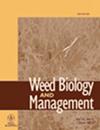意大利黑麦草(Lolium multiflorum)抗草甘膦的非靶点机制
IF 1.5
4区 农林科学
Q3 AGRONOMY
引用次数: 4
摘要
在日本静冈县,抗草甘膦的多花Lolium multiflorum是稻田和麦田堤防上的一个严重问题。分析了该生物型的抗性机理。根据LD50测定,抗性种群对草甘膦的抗性是敏感种群的2.8 ~ 5.0倍。抗性生物型的5-烯醇丙酮酰莽草酸-3-磷酸合成酶(EPSPS)基因序列在Pro106位点未出现非同义替换,在抗性生物型中未观察到该基因的扩增。采用液相色谱-串联质谱(LC-MS/MS)直接检测草甘膦及其代谢物氨基甲基膦酸(AMPA),检测施用后4 d草甘膦的代谢和转运情况。在草甘膦处理过的叶片和其他植物部位,两种生物型均未检测到AMPA。敏感型和耐药型的吸收率分别为37.90 3.63%和41.09 3.36%,差异不显著。抗性生物型在草甘膦处理过的叶片中草甘膦吸收量为91.36%(1.56%),而在未处理过的茎部和根部中草甘膦吸收量分别为79.58 3.73%、15.77 3.06%和4.65 0.89%,抗性生物型比敏感生物型多(5.90 1.17%)和少(2.76 0.44%)。结果表明,该抗性机制既不是代谢系统的获取,也不是限制草甘膦的吸收,而是限制草甘膦在静冈县抗性生物型中的转运。本文章由计算机程序翻译,如有差异,请以英文原文为准。
Non‐target‐site mechanism of glyphosate resistance in Italian ryegrass (
Lolium multiflorum
)
In Shizuoka Prefecture, Japan, glyphosate-resistant Lolium multiflorum is a serious problem on the levees of rice paddies and in wheat fields. The mechanism of resistance of this biotype was analyzed. Based on LD50, the resistant population was 2.8–5.0 times more resistant to glyphosate than the susceptible population. The 5-enolpyruvyl-shikimate-3-phosphate synthase (EPSPS) gene sequence of the resistant biotype did not show a non-synonymous substitution at Pro106, and amplification of the gene was not observed in the resistant biotype. The metabolism and translocation of glyphosate were examined 4 days after application through the direct detection of glyphosate and its metabolite aminomethylphosphonic acid (AMPA) using liquid chromatograph-tandem mass spectrometer (LC-MS/MS). AMPA was not detected in either biotype in glyphosate-treated leaves or the other plant parts. The respective absorption rates of the susceptible and resistant biotypes were 37.90 3.63% and 41.09 3.36%, respectively, which were not significantly different. The resistant biotype retained more glyphosate in a glyphosate-treated leaf (91.36 1.56% of absorbed glyphosate) and less in the untreated parts of shoots (5.90 1.17%) and roots (2.76 0.44%) compared with the susceptible biotype, 79.58 3.73%, 15.77 3.06% and 4.65 0.89%, respectively. The results indicate that the resistance mechanism is neither the acquisition of a metabolic system nor limiting the absorption of glyphosate but limited translocation of the herbicide in the resistant biotype of L. multiflorum in Shizuoka Prefecture.
求助全文
通过发布文献求助,成功后即可免费获取论文全文。
去求助
来源期刊

Weed Biology and Management
农林科学-农艺学
CiteScore
2.70
自引率
0.00%
发文量
13
审稿时长
>36 weeks
期刊介绍:
Weed Biology and Management is an international journal, published four times per year. The journal accepts contributions in the form of original research and review articles in all aspects of weed science. Contributions from weed scientists in the Asia–Pacific region are particularly welcomed.
The content of the contributions may relate to weed taxonomy, ecology and physiology, weed management and control methodologies, herbicide behaviors in plants, soils and environment, utilization of weeds and other aspects of weed science. All contributions must be of sufficient quality to extend our knowledge in weed science.
 求助内容:
求助内容: 应助结果提醒方式:
应助结果提醒方式:


